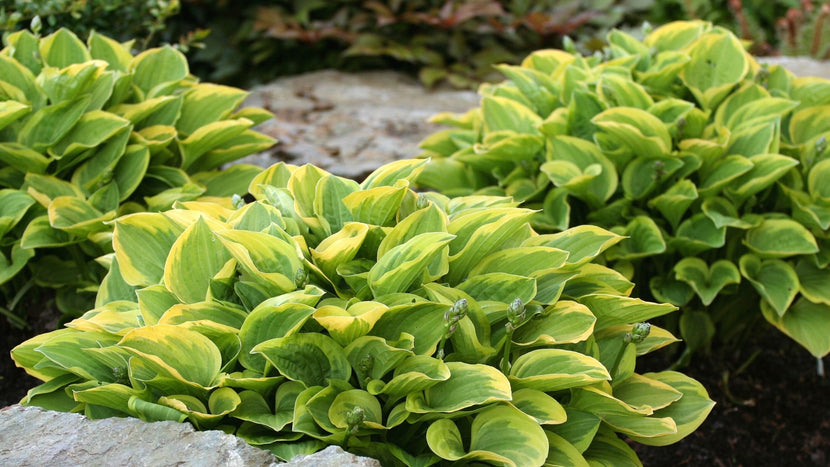How to Plant Hostas
Plant Guide

For a lovely perennial that can serve almost any purpose in your garden, choose hosta perennials. They are loved for their ability to flower in full shade, but their most notable traits are their colorful clusters of foliage. Not one variety is like the next; Blue Angel features oversized blue leaves while the Sum and Substance shines with neon green leaves.
Overall, Hostas are known to be low maintenance and can tolerate a number of conditions. With the right tips and tricks, it is not difficult to keep your Hosta happy.
Ground Rules
Light
Plantain lilies are considered one the few hostas that can tolerate more sun without their leaf quality being affected too much. Being more sun tolerant does not mean they can tolerate direct sun, however. The further north your zone, the more sun your Hosta can handle. A partially shaded area with sun dapples, or only sun in the early morning, is the best placement for your Hosta Patriot. Make sure to protect it from wind as well.
Water
Hostas like to remain in moist soil, so water regularly to maintain desired conditions. Newly planted, or transferred hostas will require more frequent waterings, but established plants can thrive from one deep watering a week. This is preferred over frequent, light waterings. Apply water to the base of the plant, rather than from the top. Excess water on the leaves can cause the leaves to burn.
Soil
Since Hostas love moist soil, porous soils that retain water without getting water logged is the best choice for these shade perennials. Make sure that the soil is rich with nutrients that will provide for the plant.
Food
The best time to apply a slow-release fertilizer to a Patriot Hosta is in the spring before the plant blooms. If you opt for a balanced granular fertilizer, you can apply it once a month to encourage continuous growth and overall health. Stop fertilizing 6 to 8 weeks before the first frost. Failure to do this will result in the hostas being vulnerable to cold winter weather and your hostas may not come back the following spring.
Temperature
Hostas are reknowned for their hardiness to low temperature, surviving down to -40 degrees Fahrenheit. If you live in these colder climates, it may be necessary to take extra precaution for the winter season.
Toxicity
Unfortunately, Hostas are poisonous to animals if ingested. If eaten, it may cause nausea or vommiting due to the glycoside saponin toxins that can be found in Hosta plants.
Mulch
Mulching helps protect the roots of your hostas and retain moisture in the soil. Since Hostas especially love moist soils, mulching is very beneficial and recommended. We recommend using organic mulches such as pine needles, shredded bark, or leaves. When organic mulches start to decompose, they add much-needed nutrients to the soil surrounding your plant. Soil after winter is over, applying a 3-inch layer around your plant but be sure to leave a gap between the base of the plant and the mulch to prevent rot.
Planting Process
- The most important thing to remember when choosing a location for your hostas is that the area is shaded. When you receive your hosta, lay the container out in the chosen location for a couple of days to allow the plant to acclimate to its new environment before putting additional stress on it by planting. When it comes time, remove the hosta from the container it came in. Dig a hole twice as wide but no deeper than the container. Gently loosen the roots at the bottom and then position your hosta plant. Backfill with a mix of the original soil and compost or topsoil.
How Do You Divide Hosta Plants?
What Is Eating My Hosta Patriot?
Why Are The Leaves Of My Hosta Turning Brown?
How Do I Propagate My Hosta?
Types of Hosta Plants
| Name: | Leaf: | Flower Color: |
|---|---|---|
| Blue Angel | Blue, extra large | White |
| Patriot | Green with cream edges | Purple |
| Guacamole | Green with blue-green edges | White |
| Sum and Substance | Neon yellow-green | Purple |
| Frances Williams | Blue center with lime green edges | White |
| Elegans | Deep green | Purple |
| Albomarginata | Dark green with white edges | Purple |
| Francee | Bright green with cream edges | Light purple |
| Blue Cadet | Blue | Purple |
| Stained Glass | Green with yellow edges | Purple |
